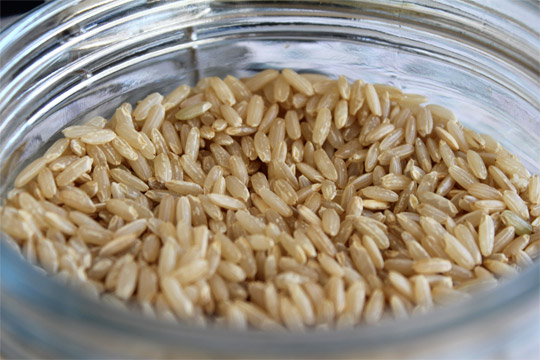
Reducing Food Waste in Foodservice
October 16, 2018 by Doreen Garelick, Dietetic Intern
Our intern Doreen attended a food waste summit for restaurants and compiled these tips to help food service operators redirect…
SPE Certified's Perfect Pantry
March 5, 2013

Senior Culinary Nutritionist Andrea Canada shares her advice on which healthy grains you should keep on hand in your kitchen or pantry.
Whole grains and minimally processed whole grain products are an essential component of a pantry stocked for health. Refined flours and white rice have been stripped of their fiber and other nutrients that make whole intact grains more balanced. While some vitamins and minerals are added back during processing (such as in ‘enriched flour’), whole, intact grains have more vitamins, minerals, protein and fiber than their refined counterparts.
Whole grains include stone-ground oats, wheat berries, barley, farro, brown rice, quinoa, amaranth and bulgur, among others. I like to buy my grains in bulk and keep them in tightly-sealed jars in the pantry, ready for use in a grain salad, soup or pilaf (such as the SPE-certified South American Quinoa Salad).
When purchasing flour, look for 100% whole wheat or whole white wheat (available from King Arthur or Bob’s Red Mill). In addition, wheat germ and oat bran are good to have as nutritious additions to cereal, yogurt and muffins. If you buy large amounts of whole grain flours or wheat germ, keep them in a sealed container in the fridge or freezer as the small amount of fat in them can go rancid over time in the pantry.
While intact grains are the least processed form of the grain and preferred, processed grain products such as breads, pastas, and crackers are generally healthier alternatives to their refined counterparts. When purchasing processed grain products, look for whole wheat pastas, 100% whole grain breads, 100% whole grain cereals with no added sugar and whole wheat bread crumbs. Look for products that say ‘100%’ and read ingredient labels to see if the flours or grains used in the product are whole.
Popcorn is one of my favorite whole grain snacks. Try to avoid the bagged popcorn that’s covered with processed cheese and salt, or heavily-oiled or buttered microwave varieties. Instead, buy kernels and pop them yourself. You can use an air-popper or create your own microwave popcorn by adding kernels to a brown paper bag, folding it closed, and microwaving until the popping slows down. You can put any variety of seasonings on your popcorn. Here at SPE Certified, we like to add a small drizzle of olive oil and nutritional yeast to our popcorn for a healthy, savory treat!

October 16, 2018 by Doreen Garelick, Dietetic Intern
Our intern Doreen attended a food waste summit for restaurants and compiled these tips to help food service operators redirect food waste from landfills.
Nutrition 101

Nutrition 101
September 26, 2018 by Doreen Garelick, Dietetic Intern
Ever notice headlines about rapid weightloss? Dietetic Intern Doreen Garelick looks deeper into a recent eye-catching headline to see if there's any truth behind it.
Connect
 Follow us on Twitter
Follow us on Twitter Friend us on Facebook
Friend us on Facebook Follow us on Pinterest
Follow us on Pinterest Follow us on Instagram
Follow us on Instagram Read our Blog
Read our Blog Watch videos on YouTube
Watch videos on YouTube Watch videos on Vimeo
Watch videos on Vimeo Connect with us on Linkedin
Connect with us on Linkedin Find us on Foursquare
Find us on Foursquare
Tweets by @SPEcertifiedBlog Search
Categories
SPE Certified Newsletter
Sign up for news on the latest SPE-certified venues, events and SPE updates.
We will never share your personal information with a third party.